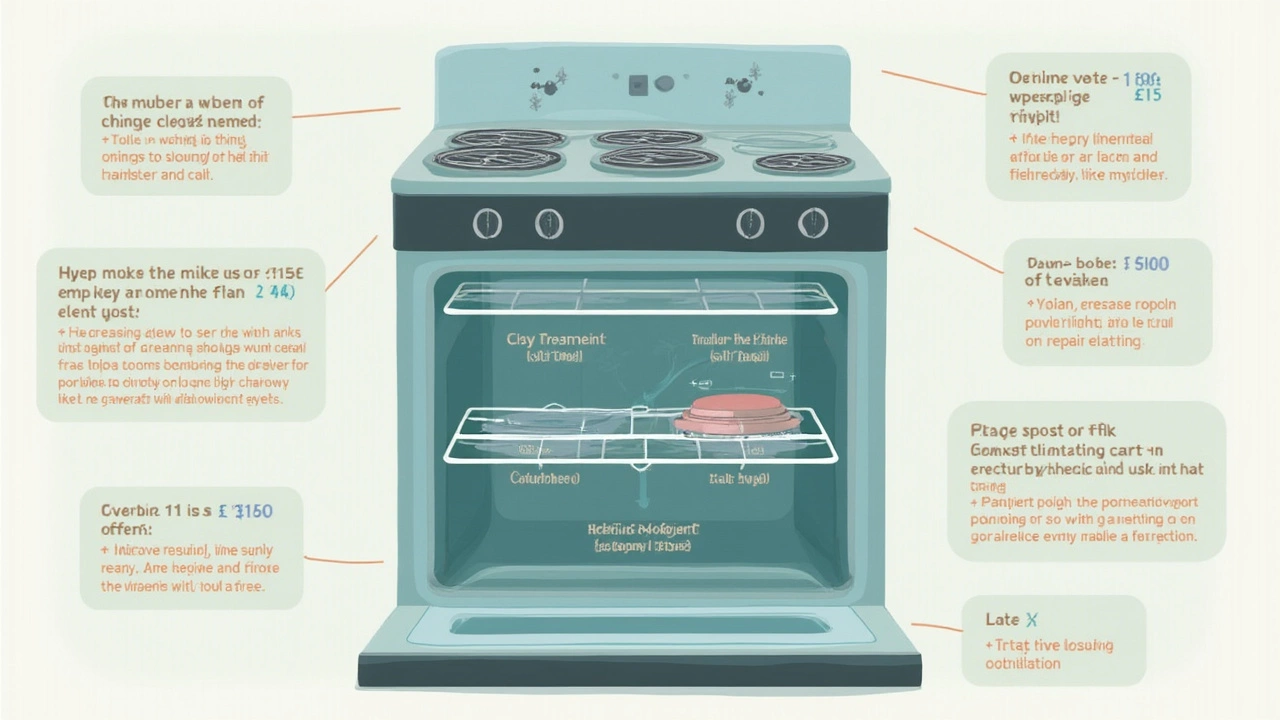If your oven's been humming along for eight years, you're probably facing that classic “Should I fix it or just buy a new one?” moment. Nobody plans for an oven breakdown—not during a busy week, and definitely not the night you promised homemade pizza. But before you drop cash on a shiny new model or call a repair shop, let’s lay out the facts.
Electric ovens aren't built to last forever. They're a lot like cars: reliable for years, but sooner or later something big needs fixing. At eight years old, your oven sits right in the middle—old enough for hiccups, but often with some life left. The key is knowing which problems are worth fixing and which signal that it’s time for an upgrade.
You might be worried about repair bills stacking up or the hassle of replacing your whole oven. That’s fair. Here, you’ll get the real scoop on how to judge an 8-year-old oven. If you’ve been side-eyeing your oven every time it burns dinner (or undercooks it), stick around. You’ll get the lowdown you need to make a smart, wallet-friendly decision.
- How Long Do Ovens Usually Last?
- Common Issues with 8-Year-Old Electric Ovens
- Repair Costs vs. Replacement Costs
- Signs Your Oven Isn’t Worth Repairing
- Tips to Extend Your Oven’s Life
How Long Do Ovens Usually Last?
Most folks are surprised to learn their oven isn’t meant to last forever. The average lifespan for a standard electric oven is about 13 to 15 years. That means if yours is turning eight this year, you’ve hit about the halfway point. Some ovens run like champs for longer, especially if they’re well-cared-for. But it’s not unusual for problems to pop up after the first seven or eight years—think of it as a nudge that maintenance matters.
Brands make a difference, but regular cleaning and not slamming the door go a long way. The type of oven matters too; wall ovens tend to last a little longer than ranges (where oven and cooktop are combined), just because the stovetop’s heat and spills don't mess with their insides as much.
| Type of Oven | Average Lifespan (Years) |
|---|---|
| Electric Range Oven | 13-15 |
| Wall-Mounted Electric Oven | 14-16 |
| Gas Oven | 15-17 |
Here’s a quick rundown of what affects how long your oven sticks around:
- oven repair habits: Fixing little things early keeps big stuff from going wrong.
- Cleaning: Grease and food bits inside break things over time.
- Power surges: Those electrical hiccups? They wear out key parts.
- How often you use it: Baking every day? You’ll probably see issues sooner.
If you’ve been gentle and kept up with repairs, your oven could beat the average. But if you’re baking for a big family every night and skipping maintenance, you’ll see that wear and tear show up faster.
Common Issues with 8-Year-Old Electric Ovens
Eight years sounds like middle age in the life of an electric oven. At this point, some parts start wearing out and things aren’t working like they used to. Here’s what folks typically run into with an oven that's been doing duty for almost a decade.
- Oven repair calls spike because heating elements burn out or start failing. If your oven takes forever to preheat or cooks unevenly, the heating element is a prime suspect. A new one usually isn’t too pricy, but labor adds up if you’re not handy.
- The thermostat can get wonky. Suddenly, you bake cookies at 350 and they come out half-done. If you’re forced to guess what temperature it’s really at, the sensor or thermostat might need replacing.
- Control boards sometimes start glitching after years of heat and steam. Flaky touchpads, lights that won’t turn off, or settings that won’t respond aren’t just annoyances—they can mean the main board is toast.
- Door problems creep up, too. Hinges can get loose, the gasket (that rubber seal) might stop sealing, and heat escapes, driving up your energy bill and messing with your cooking times.
- Random electrical issues—like tripped breakers or flickering lights—tend to show up around this age, thanks to wiring wear or control panel breakdowns.
Here’s a quick look at the most reported issues with electric ovens around the 8-year mark:
| Issue | Typical Cause | Fix Cost Range |
|---|---|---|
| Heating Element Failure | Wear/age | $80–$250 |
| Faulty Thermostat/Sensor | Component fatigue | $120–$250 |
| Broken Control Board | Heat, moisture | $200–$400 |
| Door Seal Leak | Worn gasket/hinge | $70–$180 |
| Electrical Issues | Wiring, fuse, board | $90–$350 |
Most of these repairs are doable, but if problems pile up, it can start costing more than an oven with warranty and new features. If you see smoke or smell burning plastic, don’t mess around—stop using it and call a technician.

Repair Costs vs. Replacement Costs
Deciding between repairing or replacing your oven repair job can feel like a guessing game, but it’s really about the numbers. You want the most bang for your buck, so let’s get into the real costs you’re facing.
For most households, a typical electric oven repair—think replacing a faulty heating element, bad thermostat, or busted control panel—runs anywhere from $120 to $400. If your oven just needs a new bake element, you might only spend $100 to $200 including labor. Bigger jobs, like major electrical board or wiring fixes, can quickly jump to the $350-$600 range. That’s before taxes and any trip fees the repair tech might tack on.
Replacing your old oven? The price gap can be huge. A simple, no-frills electric oven costs about $400–$700, but mid-range models with a few perks (like air fry or convection) usually fall between $800 and $1,500. If you’ve got your eye on something fancy with WiFi features or touchscreen controls, $1,600 and up isn’t unusual. Then add on installation and haul-away fees—often $150–$300 total.
| Type | Low-End | Average | High-End |
|---|---|---|---|
| Repair | $100 | $300 | $600 |
| Replacement (Oven Only) | $400 | $1,150 | $2,000+ |
| Install & Haul Away | $150 | $225 | $300 |
So how do you know what makes sense? Most pros say if your repair costs are more than half the price of a new oven, it’s probably smarter to replace. For an 8-year-old oven, this rule gets even stricter since it’s already middle-aged. And remember, fixing one part now doesn’t mean something else won’t fail soon after.
- If the repair is small (like a door gasket or bake element), fix it.
- If you’re staring at a control board failure or repeated problems, consider replacing—especially if you want better energy efficiency or new features.
- If your oven’s already had several costly repairs in the past 2 years, replacement usually makes more sense.
Bottom line? Grab an estimate from a reliable technician before making a call. Sometimes a minor repair buys you years more cooking. Other times, putting that money toward a new appliance saves you bigger headaches down the line.
Signs Your Oven Isn’t Worth Repairing
Let’s cut to it—not every oven is worth nursing back to health. Some repairs end up costing more than just buying another oven. Here’s how you spot when hanging on just isn’t worth it.
- Repair cost is more than half the price of a new oven: If fixing your electric oven is going to set you back more than 50% of what a new one costs, it’s rarely a good deal. Once you’re hitting that price point, you could be throwing good money after bad.
- It keeps breaking down: Needing repairs more than once a year is a bad sign. Ovens hitting the 8-year mark shouldn’t act like drama queens with constant issues. If you’re always calling the repair guy, it may be time to let go.
- Major parts are shot: When critical components like the control panel or heating element fail, the bill skyrockets. These aren’t little fixes—think of it like your car losing the engine or transmission.
- It’s inefficient or slow: Modern ovens are far more energy-efficient. If yours takes forever to preheat or burns through watts, the energy costs add up. It might save you money in the long run to upgrade.
- You can’t get parts: For some older models, finding replacement parts is a nightmare or impossible. If your manufacturer barely supports your model, repairs get tricky and expensive—or simply unavailable.
Check out some average costs and life stats so you’re not just guessing:
| Typical Repair | Average Cost (USD) |
|---|---|
| Heating element | $150 - $300 |
| Control board | $200 - $400 |
| Door replacement | $100 - $250 |
| Thermostat | $100 - $200 |
| Oven Age | Likelihood of Needing Major Repair |
|---|---|
| Less than 5 years | Low |
| 6–10 years | Medium |
| Over 10 years | High |
And here’s a quick gut-check: An 8-year-old oven isn’t young, but it usually isn’t ancient either. If repairs are creeping toward that 50% mark, or you’re noticing a pattern of new problems popping up, don’t force it. Put your money into a reliable, efficient replacement and skip the stress.

Tips to Extend Your Oven’s Life
If you want more years from your current oven, a few simple habits go a long way. I’m not talking about deep cleaning every weekend, but a little regular care can keep things running strong (and keep your meals from getting weird surprises).
- Oven repair isn’t just about fixing breaks—it’s about stopping them before they start. Always wipe down spills as soon as the oven cools. Food gunk hanging around can burn, mess with the sensors, and even cause smoke that sets off alarms at the worst time.
- Every few months, check the oven door seal. If that rubbery gasket looks cracked or loose, heat is escaping and you’re wasting cash. Swapping it out is easy and can boost efficiency right away.
- Don’t ignore weird noises or uneven cooking. These are red flags. If you catch them early, repairs are usually cheaper. Waiting until it totally quits? That’s almost always pricier.
- Run a self-clean cycle only when you really need it. Too much self-cleaning can wreck heating elements over time. Spot cleaning with a damp cloth gets the job done for everyday mess.
- If you use foil to catch drips, make sure it’s not blocking vents or covering the oven floor. Blocking airflow traps heat, which strains the parts you want to last.
- If you like DIY projects, give the control knobs and buttons a wipe with a dry cloth. Keep water away from electronics. Moisture sneaks in, causes corrosion, then bam—sudden repairs needed.
Ever wondered how long you can reasonably expect your oven to last? Here’s a quick look, based on real-world numbers:
| Maintenance Level | Typical Oven Lifespan |
|---|---|
| Minimal (just basic use, rare cleaning) | ~7 years |
| Basic (wipe spills, check seal, occasional service) | ~10 years |
| Above Average (routine checks, smart use, prompt fixes) | ~13 years |
A few good habits early on mean fewer headaches and big repair bills later. Even if your oven is already eight years old, giving it a bit of TLC can squeeze out a few more birthdays—and keep you from having to bake cookies in the neighbor’s kitchen.





